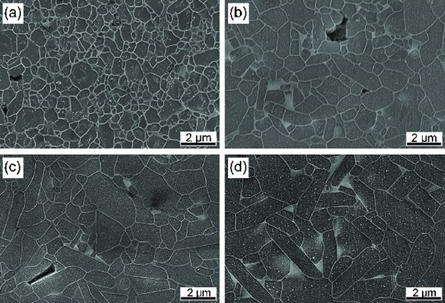
- English
- Español
- Português
- русский
- Français
- 日本語
- Deutsch
- tiếng Việt
- Italiano
- Nederlands
- ภาษาไทย
- Polski
- 한국어
- Svenska
- magyar
- Malay
- বাংলা ভাষার
- Dansk
- Suomi
- हिन्दी
- Pilipino
- Türkçe
- Gaeilge
- العربية
- Indonesia
- Norsk
- تمل
- český
- ελληνικά
- український
- Javanese
- فارسی
- தமிழ்
- తెలుగు
- नेपाली
- Burmese
- български
- ລາວ
- Latine
- Қазақша
- Euskal
- Azərbaycan
- Slovenský jazyk
- Македонски
- Lietuvos
- Eesti Keel
- Română
- Slovenski
- मराठी
- Srpski језик
Why Choose Pressureless Sintering for SiC Ceramic Preparation?
2024-09-06
Silicon carbide (SiC) ceramics, known for their high hardness, high strength, high-temperature resistance, and corrosion resistance, find extensive applications in aerospace, petrochemical, and integrated circuit industries. Given that most SiC products are high-value-added items, the market potential is substantial, garnering significant attention from various countries and becoming a focal point of materials science research. However, the ultra-high synthesis temperature and the difficulty of achieving dense sintering of SiC ceramics have limited their development. The sintering process is crucial for SiC ceramics.
How Do Sintering Methods Compare: Reaction Sintering vs. Pressureless Sintering?
SiC, as a compound with strong covalent bonds, exhibits low diffusion rates during sintering due to its structural characteristics that provide high hardness, high strength, high melting point, and corrosion resistance. This necessitates the use of sintering additives and external pressure to achieve densification. Currently, both reaction sintering and pressureless sintering of SiC have seen significant advancements in research and industrial application.
The reaction sintering process for SiC ceramics is a near-net-shape sintering technique, characterized by minimal shrinkage and size changes during sintering. It offers advantages such as low sintering temperatures, dense product structures, and low production costs, making it suitable for preparing large, complex-shaped SiC ceramic products. However, the process has drawbacks, including a complex initial preparation of the green body and potential contamination from by-products. Additionally, the operating temperature range of reaction-sintered SiC ceramics is limited by the free Si content; above 1400°C, the material’s strength decreases rapidly due to the melting of free Si.

Typical microstructures of SiC ceramics sintered at various temperatures
Pressureless sintering technology for SiC is well-established, with benefits including the ability to use various forming processes, overcoming limitations on product shape and size, and achieving high strength and toughness with appropriate additives. Furthermore, pressureless sintering is straightforward and suitable for mass production of ceramic components in different shapes. However, it is more expensive than reaction-sintered SiC due to the higher cost of the SiC powder used.
Pressureless sintering mainly includes solid-phase and liquid-phase sintering. Compared to solid-phase pressureless sintered SiC, reaction-sintered SiC exhibits poor high-temperature performance, especially as the flexural strength of SiC ceramics drops sharply above 1400°C, and they have poor resistance to strong acids and bases. Conversely, pressureless solid-phase sintered SiC ceramics show superior mechanical properties at high temperatures and better corrosion resistance in strong acids and bases.

Technology for Fabrication of Reaction-bonded SiC
What Are the Research Developments in Pressureless Sintering Technology?
Solid-Phase Sintering: Solid-phase sintering of SiC ceramics involves high temperatures but results in stable physical and chemical properties, particularly maintaining strength at high temperatures, offering unique application value. By adding boron (B) and carbon © to SiC, boron occupies the SiC grain boundaries, partially substituting carbon in SiC to form a solid solution, while carbon reacts with surface SiO2 and impurity Si in SiC. These reactions reduce grain boundary energy and increase surface energy, thereby enhancing the driving force for sintering and promoting densification. Since the 1990s, using B and C as additives for pressureless sintering of SiC has been widely applied in various industrial fields. The main advantage is the absence of a second phase or glassy phase at the grain boundaries, resulting in clean grain boundaries and excellent high-temperature performance, stable up to 1600°C. The drawback is that complete densification is not achieved, with some closed pores at the grain corners, and high temperatures can lead to grain growth.
Liquid-Phase Sintering: In liquid-phase sintering, sintering aids are typically added in small percentages, and the resultant intergranular phase may retain considerable oxides post-sintering. Consequently, liquid-phase sintered SiC tends to fracture along grain boundaries, offering high strength and fracture toughness. Compared to solid-phase sintering, the liquid phase formed during sintering effectively lowers the sintering temperature. The Al2O3-Y2O3 system was one of the earliest and most attractive systems studied for liquid-phase sintering of SiC ceramics. This system enables densification at relatively low temperatures. For instance, embedding samples in a powder bed containing Al2O3, Y2O3, and MgO facilitates liquid phase formation through reactions between MgO and surface SiO2 on SiC particles, promoting densification through particle rearrangement and melt reprecipitation. Additionally, Al2O3, Y2O3, and CaO used as additives for pressureless sintering of SiC result in Al5Y3O12 phases forming in the material; with increasing CaO content, CaY2O4 oxide phases appear, forming rapid penetration paths at grain boundaries and improving the material’s sinterability.
![]()
How Do Additives Enhance Pressureless Sintering of SiC Ceramics?
Additives can increase the densification of pressureless sintered SiC ceramics, lower the sintering temperature, alter the microstructure, and improve mechanical properties. Research on additive systems has evolved from single-component to multi-component systems, with each component playing a unique role in enhancing SiC ceramic performance. However, introducing additives also has downsides, such as reactions between additives and SiC that produce gaseous by-products like Al2O and CO, increasing material porosity. Reducing the porosity and mitigating the weight loss effects of additives will be key research areas for future liquid-phase sintering of SiC ceramics.**
We at Semicorex specialize in SiC Ceramics and other Ceramic Materials applied in semiconductor manufacturing, if you have any inquiries or need additional details, please don't hesitate to get in touch with us.
Contact phone: +86-13567891907
Email: sales@semicorex.com




